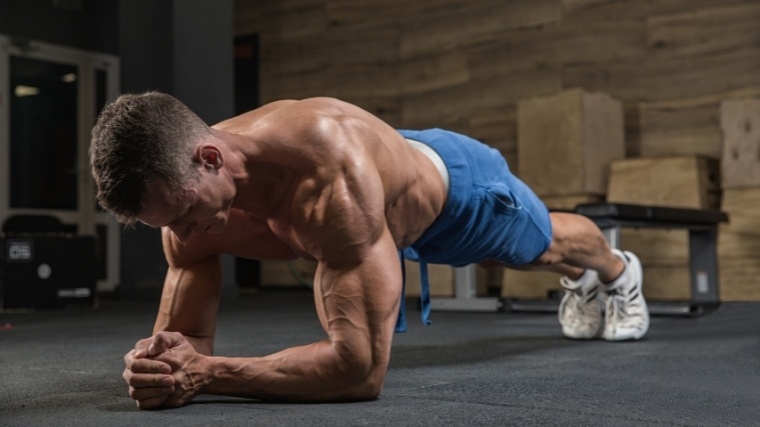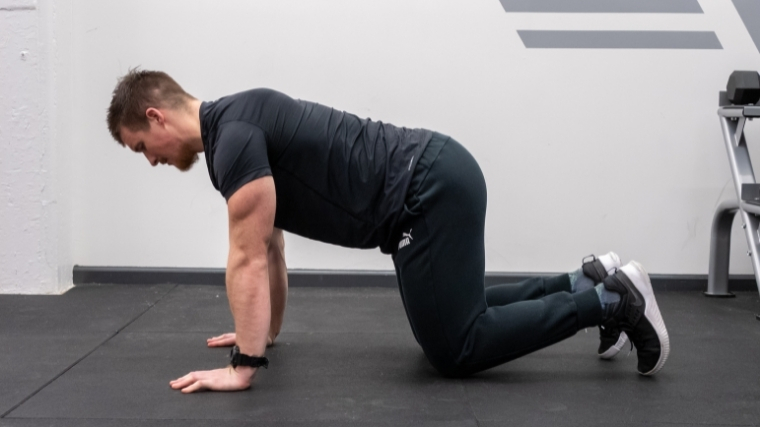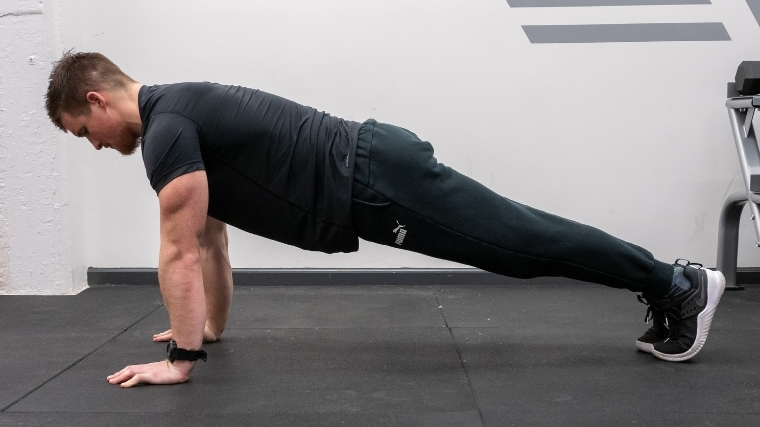Few exercises are as basic yet effective as the plank. To the untrained eye, a plank is a lazy person’s exercise. Heck, you’re not even standing up. But experienced gym-goers, or even someone who has tried a plank once, know the plank as one of the most intense core workouts conceived. As you plank, your body becomes a bridge. Your feet and hands are the pillars of support, and all the muscles in between — your abs, spinal erectors, obliques, and the amalgam of muscles in your upper back — are now working overtime to ensure you don’t topple over.
An exercise couldn’t be more simplistic on paper, but the plank is far more nuanced than most people know. Below, we’ll go over every detail you need to master the plank and then go over set and rep recommendations, alternatives, and plank variations. Brace yourself: Your ab workouts just got a whole lot better.
- How to Do the Plank
- Benefits of the Plank
- Muscles Worked by the Plank
- Who Should Do the Plank
- Plank Sets, Reps, and Programming Recommendations
- Plank Variations
- Plank Alternatives
- Frequently Asked Questions
How to Do the Plank
Below are two step-by-step guides on how to perform the bodyweight plank. Note: You can do the plank on your forearms or hands.
Step 1 — Set Up the Plank
Get on your hands and knees and ensure that your hands are under your shoulders and your knees are under your hips. Extend your feet back so that your knees are off the ground. Be sure not to shift weight back or forwards when you do this.
Form Tip: Squeeze your core, but also your glutes, quads, hamstrings, and triceps. The more muscles you flex at once, the harder your overall plank should be.
Step 2 — Brace and Hold
Once you are in the plank position, focus on maintaining a flat spine and tight core. As you hold the plank position, focus on keeping the upper back flat (by actively pressing through the hands into the floor) and then pressing the legs together.
Form Tip: Don’t let your hips drop. It can be helpful to have someone help you find the proper positioning and keep you diligent in maintaining it.
Benefits of the Plank
Don’t let the basic nature of the plank fool you. Here are three benefits you’ll reap by adding planks into your routine.
Core Strength
For some lifters, core strength may actually be a limiting factor during loaded movements like heavy squats and deadlifts. Adding planks into a training program that already includes loaded movements can help a lifter understand what it feels like to contract the core maximally and/or enhance a lifter’s ability to contract the core for longer periods of time.
A Better Ability to Brace
Bracing your core is an absolute must while you’re lifting heavy weights — it’s what protects your spine from unwanted torsion. Proper bracing starts with your core muscles, front and back. You need to squeeze them as hard as possible, so it stands to reason that a stronger core means a better ability to brace and for longer periods of time.
Healthier Movement
The plank trains the muscle groups and positioning used in most strength, power, and fitness movements (neutral spine). While the plank itself is a stationary movement, it reinforces proper pelvic and spinal stabilization and increased muscle activation and strength of the obliques, abdominals, and deeper core muscles.
Muscles Worked by the Plank
The plank is a core movement with a wide application to strength, power, fitness sports, exercises, and training. The below muscles are worked in an isometric manner to support strong core growth and reinforce proper core tension and bracing capacities both with and without load.

Rectus Abdominis
The rectus abdominis, known as the six-pack muscle, is automatically contracted in this exercise to resist spinal extension. They are responsible for spinal flexion.
Transverse Abdominals
The transverse abdominals are deeper core muscles (underneath the rectus abdominis) and stabilize the core during every exercise. This muscle is taxed during squatting, deadlifting, and most loaded movements.
Gluteals
Squeezing the glutes (gluteals) can also help to contract the core hard, often used in the plank and other strength lifts as a performance-enhancing cue.
Who Should Do the Plank?
The short answer is: Everyone. But here’s a more in-depth breakdown of the different athletes who can benefit from planks and how.
Strength and Power Athletes
Planks are a beneficial exercise for powerlifters, weightlifters, and strongman athletes; as they increase core strength, ability to brace, and proper core stabilization and positioning needed for loaded movements like carries, squats, deadlifts, and overhead presses. Additionally, they can help to increase strength and muscle hypertrophy of the abdominals/obliques/and deeper core muscles, all of which are active in strength and power competition lifts and most functional fitness exercises.
Everyone Else
The plank is a foundational core strengthening exercise that challenges isometric control and strength of the abdominals, obliques, and spinal stabilizers. You can progress the plank to be a more challenging variation to increase dynamic core strength and functional fitness.
Plank Sets, Reps, and Programming Recommendations
Here are two different ways to add planks into your program based on goals. Note: Planks are trained either after main strength movements (as to not pre-fatigue the core strength needed for movements like squats, deadlifts, etc.) or warm-up to activate the central nervous system and muscles.
To Gain Core Strength
For general core strength and development, athletes can use a combination of load and non-loaded planks. Start with the below recommendations, then increase the difficulty by either adding more time to your plank or more weight. Do two to three sets of 45-60 seconds, resting 60-90 seconds between sets. You can add weight to the plank by stacking bumper plates on the middle back. It’s best if you have a friend to help you with this.
To Improve Muscle Endurance
Increased core endurance and stamina can be developed with longer duration sets and increased time under tension. Try performing two to four sets of one to two minutes, resting 30-60 seconds between. You can add planks to total body circuits as active rest periods for more advanced training programs.
Plank Variations
Below are three plank variations that coaches and athletes can use to keep training varied and progressive.
Side Plank
The side plank is done nearly the same as the regular plank, except that the lifter is performing the movement on their side (with their feet and elbow/forearms on the ground). This exercise challenges the isometric strength of the transverse abdominals, obliques, and scapular stabilizers.
Bodysaw Plank
The bodysaw plank is a plank done with the feet on sliders, a foam roller, or another moveable surface. When in the plank position, the athlete slides their legs backward, maintaining a neutral spine and a contracted core. This exercise also reinforces proper scapular stability and strength and is a good scapular warm-up for movements like squats, presses, and overhead movements.
Three-Point Plank
This plank variation has you lift one foot off of the ground. You can either hold one foot off the ground for time or alternate feet by picking one up, holding it for a second or two, placing it back on the floor, and then picking the other up. By having one foot off of the ground during an active plank, your body will be that much more off-balance, which will force your core to work harder to stabilize your body, so it stays in place.
Plank Alternatives
Below are three plank alternatives coaches and athletes can use to increase abdominal strength and muscle hypertrophy/endurance.
L-Sit Hold
L-sit holds are challenging core exercises that require great amounts of isometric core and hip flexor strength as you support your entire body off the floor with your legs extended. This gymnastic-based movement is highly challenging to the obliques as well.
Reverse Plank
This plank alternative can be done both from a supine and prone position and entails the lifter to place both their feet and upper back/chest onto a bench, suspended over the ground like a bridge. This is extremely challenging and forces a stronger hollow hold position and/or reinforces proper back extension.
Bird Dog Plank
The bird dog plank/hold is a great exercise for reinforcing core stability while incorporating hip and shoulder movement. In doing so, you can reinforce proper bracing and spinal stability during movements that require leg and arm movements. Additionally, the bird dog plank requires greater stabilization and anti-rotational stability due to the imbalanced positing of the plank.
FAQs
Are planks a beginner-friendly exercise?
When done correctly, yes. Be sure to review the above plank step-by-step guide. If you cannot do planks for prolonged periods of time, you can do them for shorter durations — like 10 seconds — and work your way up.
How can you make planks more difficult from home?
You can progress planks at home by adding weight to the back, having a partner apply pressure to your back as you do planks, or hold them for more time.
If you find yourself being able to do planks for minutes on end, there is a strong likelihood that you would benefit from training the body from externally loading carries, front carries, or doing other plank variations or core exercises to progress.
How heavy can you train planks?
If you are looking to really load up planks, you can do so with however much weight you feel necessary, provided you can still maintain good spinal and pelvic stability.
If you are a serious strength athlete, you may be more likely to find benefit doing loading carries or focusing on moving weight with heavier compound exercises like back squats, front squats, farmer carries, etc. if your goal is to be able to use your core strength for lifts and movements.
Featured image: Lebedev Roman Olegovich/Shutterstock

